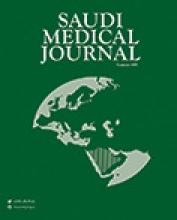Abstract
OBJECTIVE: To find out prevalence rate of urine incontinence (UI) in a representative sample of women aged 50-65 years in south Jordan. The study will also investigate the relationship between UI (stress and urge) and the following variables: age of the woman and her parity, diabetes mellitus, urinary tract infection (UTI), body mass index (BMI), medications (diuretics), menopause, past history of hysterectomy, and poor mobility.
METHODS: For achieving the objectives of this study, a sample of women (n=182) in the age group 50 - 65 years in south Jordan (Karak, Taffileh, Aqaba) was selected using a multistage sampling procedure to represent women in this age group in south Jordan. A questionnaire and face-to-face interviews were used as the instrument for data collection. The questionnaire was tested in a pilot study before starting data collection from the field. Data was collected from the field in July 2003. Data was analyzed using Statistical Package for Social Science (SPSS). Chi Square Test and Fisher's Exact Probability Test were used to identify the significance of associations between UI and characteristics of the respondents.
RESULTS: Approximately one third of respondents had urinary incontinence; 23.1% had stress UI, 26.4% had urge UI, and 18.1% had the mixed type. Prevalence rate of UI was 56.3% for women suffering from UTI and 50% for those who use diuretics. Approximately 54% of women who need help to go around inside the house were complaining of UI. High prevalence rates were also observed if parity was 5 - 6 (43.5%), women at menopause (39.7%), obese women (39.3%), and in diabetic women (35%). High prevalence rates of stress incontinence were found in women suffering from UTI (37.5%), in women using diuretics (39.5%), if parity was 5 - 6 (34.8%), and in women with past history of hysterectomy (28.6%). Stress UI was increasing with the increase in the BMI. The associations between urge incontinence, BMI, UTI, use of diuretics, and the ability to go around inside the house were all significant at the 0.05 level.
CONCLUSION: Prevalence rate of UI varied from one country to another and from one study to another study. Possible reasons for such inconsistency were discussed. Appropriate treatment of UI should be based on valid diagnosis of cases, type of UI, and the identification of contributing factors. Lines of treatment and interventions for UI were discussed. Further studies of this condition are needed in Jordan for both males and females and in all age groups. Such studies should emphasize the size of the problem, etiology and risk factors, and the cost of the problem for both the incontinent person and for the health care system.
- Copyright: © Saudi Medical Journal
This is an open-access article distributed under the terms of the Creative Commons Attribution-Noncommercial-Share Alike 3.0 Unported, which permits unrestricted use, distribution, and reproduction in any medium, provided the original work is properly cited.






